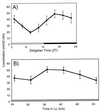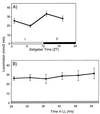Circadian modulation of dopamine receptor responsiveness in Drosophila melanogaster
- PMID: 10677549
- PMCID: PMC26529
- DOI: 10.1073/pnas.97.4.1873
Circadian modulation of dopamine receptor responsiveness in Drosophila melanogaster
Abstract
We investigated the circadian function of Drosophila dopamine receptors by using a behaviorally active decapitated preparation that allows for direct application of drugs to the nerve cord. Quinpirole, a D2-like dopamine receptor agonist, induces reflexive locomotion in decapitated flies. We show that the amount of locomotion induced changes as a function of the time of day, with the highest responsiveness to quinpirole during the subjective night. Furthermore, dopamine receptor responsiveness is under circadian control and depends on the normal function of the period gene. The head pacemaker is at least partly dispensable for the circadian modulation of quinpirole-induced locomotion, because changes in agonist responsiveness persist in decapitated flies that are aged for 12 h. This finding suggests a role for the period-dependent molecular oscillators in the body in the modulation of amine receptor responsiveness.
Figures



References
Publication types
MeSH terms
Substances
Grants and funding
LinkOut - more resources
Full Text Sources
Molecular Biology Databases

